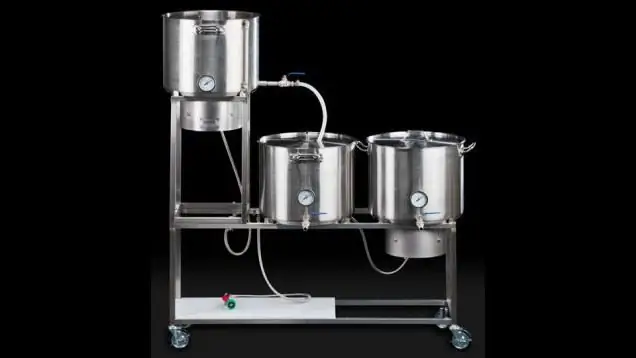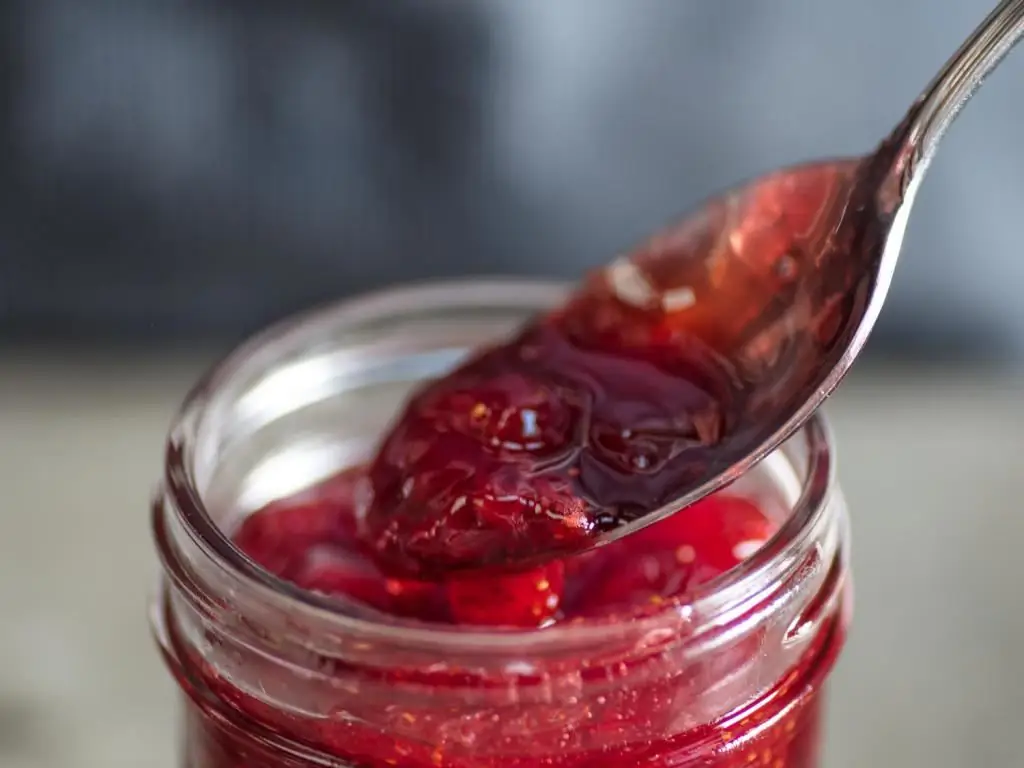2025 Author: Isabella Gilson | [email protected]. Last modified: 2025-01-23 12:50:41
Marmalade is a dessert that appeared when a person learned to harvest fruits for future use by boiling them. In confectionery practice, it is customary to use products that contain pectin for its preparation. This is a natural gelling agent, which allows it to keep its shape after cooling. What they sell in the store today is a mixture of gelatin and dyes. Therefore, if you want to please your family with a natural dessert, you will have to cook marmalade at home.

Components
Despite the apparent complexity, it is quite within the power of every housewife. After all, you are making jams and jams, which are quite thick and reluctant to leave the jar after solidification. Marmalade at home is made according to the same principle.
For cooking, you need mashed fruit with sugar. This puree must be rubbed several times through a sieve with small holes, which allows you to get the perfect consistency, without lumps. The consistency of the future product is determined by the amount of sugar. Soft marmalade at home is prepared with the addition of 300 g of granulated sugar per kilogram. If you want to get a dense dessert, then the proportion is 1/1.
What fruits can I take
If you don't want to use an extra thickener, it's best to choose fruits with a high pectin content. These are apples, apricots, quince. Marmalade made from them at home is stored very well, has an excellent taste and aroma of fresh fruits. For cooking, only ripe, even overripe fruits are used. Feel free to add gooseberries, currants, you get even denser jelly.
If sugar is forbidden for you, then you can add honey, fructose or stevia. The taste and price of the finished product change, but the marmalade still turns out to be very good and he althy.

Natural thickeners
And how to make marmalade at home from berries or fruits that do not contain pectin? Like raspberries, for example? There are two options here. Either make a mix by adding red currants to it, or just buy a bag of one of the gelling agents. The choice today is very large, with no chemistry, everything is only natural:
- Pectin. This is an extract of their pomace and fruit peel, which is sold today in any store.
- Agar-agar. Natural thickener derived from marinealgae.
- Gelatin - an extract from veins and bones.

General rules
Pre-peeled and crushed fruits are boiled in water to give them the appropriate consistency. Any recipe for marmalade at home begins with mashed potatoes. To do this, apples can be baked and rubbed through a sieve. The main thing is to get a homogeneous mass.
After that, you can start cooking dessert. Simple marmalade at home can be prepared by following this rule. The shorter the cooking time, the faster the evaporation of moisture and the better the product. It is cooked in a wide bowl with a thick bottom and low sides. It is necessary to constantly stir the puree during cooking. Readiness can be judged by the following signs:
- Drip a little on a cold dish. If the drop does not spread, then you can turn it off.
- If while stirring the fruit puree, you see that the trace of the spoon does not spread, then it is ready.
But many housewives make a mistake. They pour the mass into a jar and simply leave it at room temperature. In this case, it turns out fruit jelly, not quite what we need. So how to make marmalade at home not only natural, but also identical to the real one in consistency?
The hot product is packaged in jars and twisted. After that, they are placed in a basin of water and gradually cooled. This forms the correct dense consistency.

Alternative way
This is a great dessert option, but it will still look like regular jam in a jar. Therefore, there are other ways that you can take note:
- put the finished mass in an even layer on a flat dish;
- use cookie cutters;
- you can not boil the fruit puree, but leave it to dry in the air, laying it out in a thin layer;
- spread on a baking sheet and dry in the oven for an hour and a half at a temperature of 50 degrees.
Easiest recipe
Marmalade at home can be prepared on the basis of fruit juices, both homemade and store-bought. This option is very economical in time, it will definitely be appreciated by a busy hostess. So, you will need:
- juice - 1 liter;
- gelatin - 5 tablespoons;
- sugar - 2 tablespoons.
The amount of sugar does not play a big role here, because boiling will not occur. Gelatin acts as a thickener. Therefore, be guided only by your own taste.
- Gelatin is required to pour a glass of juice and leave for 10 minutes.
- After that, heat the rest of the liquid a little and add sugar.
- Dissolve gelatin in a water bath.
- Pour the slightly cooled mass onto a baking sheet and wait for complete solidification. After that, cut the mass into cubes and roll in sugar.
With gelatin marmalade at home is prepared in minutes, but it turns out tasty and he althy.

Universal marmalade recipe
At home, you can use any fruits and berries, as well as combine them with each other. The result is a tasty and he althy treat. The ingredients are as follows:
- berry or fruit puree - 500 g;
- sugar - 400 g;
- pectin - 12 g (if apples are used, you can omit);
- lemon juice - 70g;
- vanillin, lemon peel.
Place fruit puree in a heavy bottomed saucepan and bring to a boil. After that, add a mixture of pectin and sugar and boil for another 5 minutes. This mixture must be boiled to medium density. Do not forget to stir constantly, the taste of burnt in marmalade is completely useless.
Lemon juice and zest, vanilla and other aromatic spices are added to the finished mixture. Now you need to pour the finished mass into the prepared form. So far - it's still fruit jelly. It needs to be wrapped in foil and kept in the cold for two days. After that, the marmalade is turned over and left for another two days. After that, the finished product must be cut into pieces and rolled in sugar. It turns out an excellent dessert that can be given to children without fear.

Instead of a conclusion
Now you know how to make marmalade at home. It is not difficult at all, and you can try to treat your family with such a delicacy. By the way, for cooking, you can use not only fruit or berry puree. Pumpkin is also excellent for such purposes. Preboiled and mashed to a puree, it will make an excellent base. You can supplement it with citruses, apples, plums, any other product of your choice. After such experiments, you will definitely not want to buy marmalade in the store, because it contains nothing but chemical flavors and dyes.
Recommended:
Home breweries: reviews. Home mini-brewery. Home Brewery: Recipes

What makes homebreweries so good? Reviews of those who have already used these machines for making beer, various important nuances and advantages of such an acquisition - all this can be read in the text below
Chewing marmalade: history, preparation process and a few words about the largest producers: marmalade "Fru-fru" and "Haribo"

Let's learn the legend about the origin of marmalade, its transformations, cooking methods. Let's take a look at the factory to find out how one of the favorite sweets of all adults and children is produced. Let's see what forms of dessert there are
Composition of marmalade. What is marmalade made from?

Marmalade is a delicacy loved by both children and adults. However, many question the benefits of this dessert. The composition of marmalade is of great interest to those who cautiously buy it for their children. What is the delicacy made of, what chemicals does it contain?
Marmalade with gelatin at home: recipe

Homemade marmalade compares favorably with store-bought counterparts. It contains no harmful dyes, thickeners and preservatives. Therefore, it turns out not only tasty, but also quite useful. This sweet delicacy is prepared according to several different recipes. The most interesting of them will be discussed in today's article
What is the difference between jam and jam, marmalade and marmalade?

What a great variety of sweet desserts was invented on the basis of berries, fruits and even some vegetables, boiled with sugar and carefully placed in jars, so enticing sweet tooth. Usually these desserts are used as a filling in homemade cakes or eaten spread on toast with hot tea. But for many of us it is difficult to understand - what is the difference between jam, jam, marmalade and confiture, what is the technology for preparing this or that fragrant dessert

